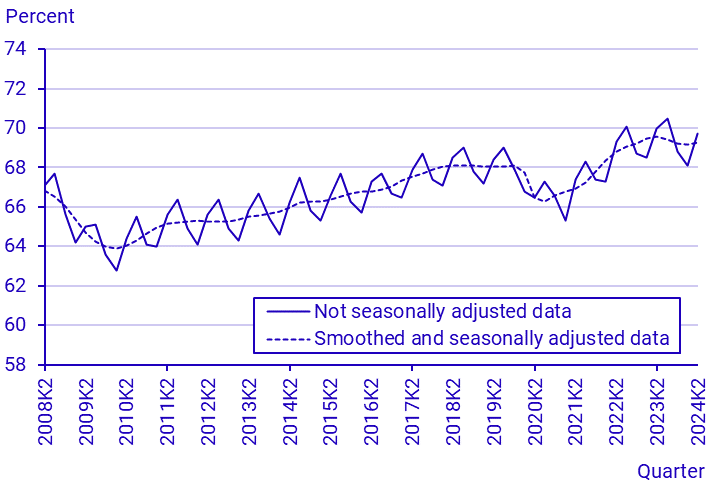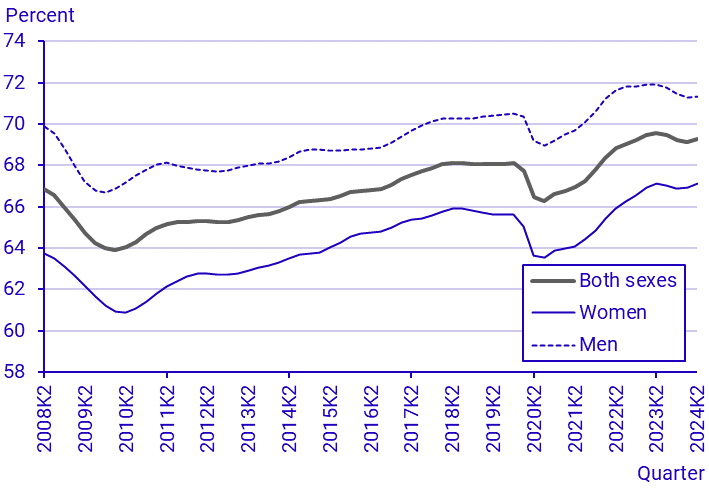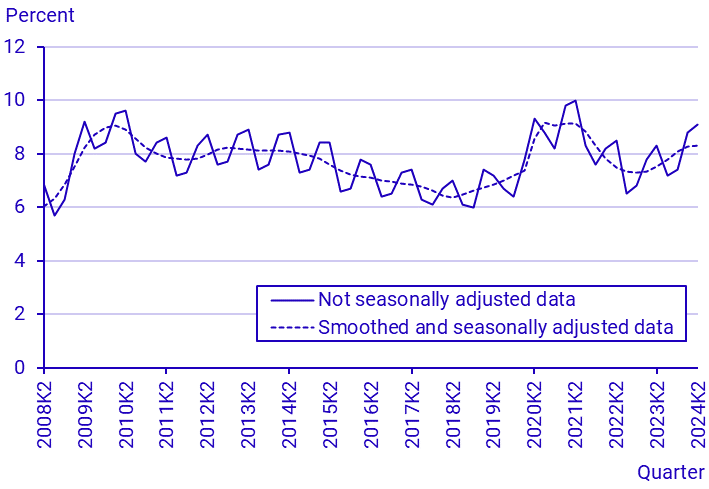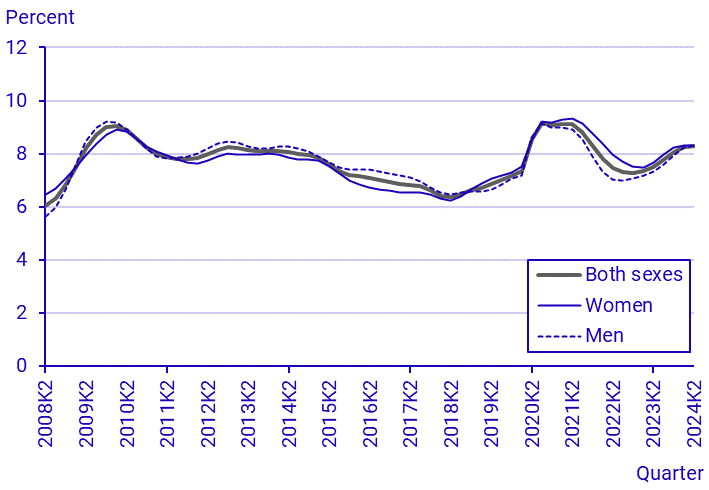Labour Force Survey (LFS), second quarter 2024
The number of temporary employees decreased in the second quarter
Statistical news from Statistics Sweden 2024-08-20 8.00
In the second quarter of 2024, the number of employed people amounted to 5 292 000, not seasonally adjusted. There were 666 000 temporary employees, a decrease of 71 000. The average number of hours worked per week amounted to 161.2 million hours. There were 528 000 unemployed people, which is an increase of 45 000 people. This corresponds to an unemployment rate of 9.1 percent, an increase of 0.8 percentage points. Seasonally adjusted and smoothed data show an increase in the number of unemployed, which amounted to 477 000. The seasonally adjusted and smoothed unemployment rate amounted to 8.3 percent.
Due to a higher recommended retirement age from 2023, the reporting of the subgroup 20–64 years has been changed to 20–65 years.
- During the second quarter, the number of temporary employees decreased, while the number of permanent employees increased. This development is mainly seen among women, says Charlotte Breitz, statistician at the Labour Force Surveys at SCB.
The labour force
The number of people in the labour force aged 15-74 years amounted to 5 820 000 during the second quarter of 2024, not seasonally adjusted. The number of women in the labour force amounted to 2 778 000 and the number of men was 3 042 000. The relative labour force participation rate amounted to 76.7 percent. Among women, the labour force participation rate was 74.5 percent and the labour force participation rate among men was 78.8 percent.
According to seasonally adjusted and smoothed data, the number of people in the labour force during the second quarter of 2024 amounted to 5 734 000, which corresponds to 75.5 percent of the population. This is an increase in both the number and the share of people in the labour force compared to adjacent quarters.
Employment
In the second quarter of 2024, there were 5 292 000 people aged 15–74 years in employment, not seasonally adjusted. This corresponds to an employment rate of 69.7 percent. Among women, the number of employed was 2 527 000 and the number of employed men was 2 765 000. The employment rate for women was 67.7 percent and among men 71.7 percent. There were 552 000 young people aged 15–24 years in employment, which corresponds to an employment rate of 46.0 percent.
For people aged 15–74 years, seasonally adjusted and smoothed data shows an increase in the share of employed people compared to adjacent quarters. Seasonally adjusted and smoothed, the number of employed people during the second quarter of 2024 amounted to 5 257 000. This corresponds to an employment rate of 69.3 percent.
Employees
In the second quarter of 2024, there were 4 785 000 employees, not seasonally adjusted. Among those, 2 379 000 were women and 2 406 000 were men. There were 4 119 000 permanent employees, an increase of 66 000. Among permanent employees, the number of women was 2 028 000, an increase of 56 000, and the number of men was 2 091 000. There were 666 000 temporary employees, a decrease of 71 000. Among them 351 000 were women, a decrease of 58 000, and 315 000 were men.
According to seasonally adjusted and smoothed, the number of employees increased and amounted to 4 750 000. Among employees, 4 107 000 had a permanent employment and 643 000 a temporary employment. The number of permanent employees increased, and the number of temporary employees decreased compared to adjacent quarters.
Hours worked
The average number of hours worked per week in the second quarter of 2024 amounted to 161.2 million hours, not seasonally adjusted. According to seasonally adjusted and smoothed data, the number of hours worked averaged to 156.8 million per week.
Most employed people have an agreed working time of 35 hours or more per week, that is, full-time work. In the second quarter of 2024, 4 139 000 people worked full time. Among them 1 839 000 were women and 2 300 000 were men, a decrease of 36 000. In total, 283 000 people worked short part-time (1–19 hours), and the number of people who worked long part time (20-34 hours) amounted to 614 000 people.
The average actual hours worked among employed people aged 15–74 years increased by 0.5 hours and amounted to 30.6 hours per week in the second quarter of 2024. Women worked 28.2 hours per week and men 32.7 hours per week, which is an increase of 0.4 hours among women and 0.5 hours among men.
Underemployment
Among employed people aged 15–74 years, 360 000 were underemployed in the second quarter of 2024, which is an increase of 31 000 compared to the corresponding quarter previous year. The number of underemployed women amounted to 174 000 and the number of men was 185 000. Underemployed people accounted for 6.8 percent of employed people.
Unemployment
In the second quarter of 2024, there were 528 000 unemployed people aged 15–74 years, not seasonally adjusted. This is an increase of 45 000 people compared to the corresponding quarter previous year. The unemployment rate amounted to 9.1 percent, an increase of 0.8 percentage points. There were 251 000 unemployed women and 277 000 unemployed men. The unemployment rate for women was 9.0 percent and the male unemployment rate was 9.1 percent.
For people aged 15–74 years, seasonally adjusted and smoothed data shows an increase in the number of unemployed people compared to adjacent quarters. The number of unemployed amounted to 477 000 in the second quarter of 2024, which corresponds to an unemployment rate of 8.3 percent.
There were 151 000 long-term unemployed people (unemployed for at least 27 weeks) aged 15–74 years in the second quarter of 2024, not seasonally adjusted. This is an increase of 31 000 compared to the corresponding quarter previous year. Among long-term unemployed people, the number of women was 68 000, an increase of 18 000, and the number of men amounted to 83 000.
There were 214 000 unemployed young people aged 15–24 years, not seasonally adjusted. This corresponds to an unemployment rate of 28.0 percent. Among unemployed young people, 134 000 people were full-time students. For people aged 15–24 years, seasonally adjusted and smoothed data shows an increase in the number of unemployed people compared to adjacent quarters. The number of unemployed young people amounted to 165 000, corresponding to an unemployment rate of 24.0 percent.
Not in the labour force
The group 'not in the labour force' includes people who are not classified as employed nor as unemployed. In the second quarter of 2024, there were 1 769 000 people not in the labour force. The number of women not in the labour force was 952 000 and the number of men was 817 000.
Among people not in the labour force, 823 000 were retired, which is a decrease of 29 000, 463 000 were full-time students and 302 000 people reported that they were on long-term sick leave.
Latent job seekers
There were 226 000 latent job seekers aged 15–74 years in the second quarter of 2024. Among them, 106 000 were women and 119 000 were men. Among young people aged 15–24 years, the number of latent job seekers was 96 000.
Unused labour supply
Unemployed people, underemployed people and latent job seekers together comprise the unused labour supply. In the second quarter of 2024, the unused labour supply averaged 25.4 million hours per week, an increase of 2.0 million hours compared to the corresponding quarter in 2023. The unused labour supply corresponds to 635 000 full-time employments with 40-hour work weeks.
Labour market for people aged 20-65 years
The population presented by the LFS is comprised of people aged 15–74 years. However, labour market participation among younger and older in this age group is considerably lower for natural reasons, as this group contains large shares of students and retired people. To better approach what can be seen as the core of the actively working population, the situation of the age group 20–65 years is described in the following section.
The relative labour force participation rate among people aged 20–65 years amounted to 88.3 percent in the second quarter of 2024, not seasonally adjusted. For women, the relative workforce participation rate was 86.1 percent, and for men 90.4 percent. Seasonally adjusted and smoothed data shows a participation rate of 87.8 percent.
In the second quarter of 2024, the share of employed people aged 20–65 years was 81.9 percent, not seasonally adjusted. For women, the corresponding figure was 80.0, and for men it was 83.8 percent. According to seasonally adjusted and smoothed data, the employment rate amounted to 81.6 percent.
According to not seasonally adjusted data, the unemployment rate in the age group 20–65 years amounted to 7.3 percent in the second quarter of 2024, an increase of 0.9 percentage points. The unemployment rate among women was 7.1 percent and for men it was 7.4 percent, an increase by 0.9 percentage points. According to seasonally adjusted and smoothed data, the unemployment rate was 7.1 percent.
Swedish born and foreign born people aged 20–65 years
The relative labour force participation rate among Swedish born people aged 20–65 years was 88.8 percent in the second quarter of 2024, not seasonally adjusted. Among Swedish born women the labour force participation rate was 87.2 percent, and among Swedish born men it was 90.2 percent, which is an increase of 0.9 percentage points. Among foreign born people aged 20–65 years, the relative labour force participation rate was 87.0 percent. The corresponding figure among foreign born women was 82.9 percent and 90.9 percent among foreign born men. According to seasonally adjusted and smoothed data, the labour force participation rate was 88.2 percent among Swedish born people and 86.8 percent among foreign born people.
In the second quarter of 2024, the share of employed Swedish born people aged 20–65 years was 85.0 percent, not seasonally adjusted. Among Swedish born women, the employment rate was 83.7 percent and among Swedish born men the employment rate was 86.3 percent. Among foreign born people, the employment rate decreased by 1.9 percentage points and amounted to 73.4 percent. Among foreign born women, the employment rate was 69.7 percent and among foreign born men it decreased by 3.0 percentage points to 76.8 percent. Seasonally adjusted and smoothed data shows that the employment rate was 84.7 percent among Swedish born people and 73.2 percent among foreign born people. This was a decrease, among foreign born people, compared to adjacent quarters.
The relative unemployment rate among Swedish born people aged 20–65 years was 4.2 percent in the second quarter of 2024, not seasonally adjusted. Among Swedish born women, the unemployment rate was 4.1 percent, and the male unemployment rate was 4.3 percent. The unemployment rate among foreign born people was 15.7 percent, an increase of 2.1 percentage points. Among foreign born women it was 16.0 percent and among foreign born men the corresponding number was 15.5 percent. Seasonally adjusted and smoothed data shows that the unemployment rate was 4.0 percent among Swedish born people and 15.7 percent among foreign born people. This was an increase for foreign born people, compared to adjacent quarters.




Source: Statistics Sweden
Definitions and explanations
Since the LFS is a sample survey, the results are subject to some uncertainty. The LFS basic tables contain uncertainty figures and refer to non-seasonally adjusted data.
Seasonally adjusted and smoothed data (trend values): data in which normal seasonal variations have been removed, then smoothed to reduce sampling error and short-term variations. Seasonally adjusted and smoothed data may be revised following new monthly outcomes and usually does not coincide with non-seasonally adjusted data. Seasonally adjusted and smoothed data is not to be compared with non-seasonally adjusted data.
More detailed results are available in the form of figures and tables on employed persons, hours worked, unemployed persons and more, on Statistics Sweden’s website.
Next publishing will be
2024-08-23, at 08:00.
Feel free to use the facts from this statistical news but remember to state Source: Statistics Sweden.
